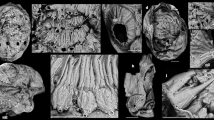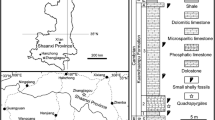Abstract
Nautilus is not suitable as a model organism to infer biological functions, embryonic development, or mode of life in ammonoids. A brief review of the available morphological data is given and molecular data are added to discuss the usefulness of Spirula as a biological proxy for ammonoids. Indeed, there are many morphological hints indicating that Spirula could be a useful model organism for approaching the embryonic development of ammonoids. The molecular data seem to support this hypothesis. However, a universal model character of Spirula cannot be detected as, e.g., the mode of feeding probably differs between Spirula and ammonoids.




Similar content being viewed by others
References
Appellöf A (1893) Die Schalen von Sepia, Spirula und Nautilus. Studium über den Bau und das Wachstum. K Svenska Vetensk Akad Handl Stockholm 25:1–106
Arnold JM, O’Dor R (1990) In vitro fertilization and embryonic development of oceanic squid. J Cephalopod Biol 1:21–36
Bandel K (1982) Morphologie und Bildung der frühontogenetischen Gehäuse bei conchiferen Mollusken. Facies 7:1–198
Bandel K (1990) Cephalopod shell structure and general mechanisms of shell formation. In: Carter JG (ed) Skeletal Biomineralization: Patterns, Processes and Evolutionary Trends. 1, pp 97–115
Bandel K, von Boletzky S (1979) A comparative study of the structure, development and morphological relationships of chambered cephalopod shells. Veliger 21:313–354
Berthold T, Engeser T (1987) Phylogenetic analysis and systematization of the Cephalopoda (Mollusca). Verh Naturwiss Ver Hamb NF 29:187–220
von Boletzky S (1989) Recent studies on spawning, embryonic development, and hatching in the Cephalopoda. Adv Mar Biol 25:85–115
von Boletzky S (1998) Cephalopod eggs and egg masses. Oceanogr Mar Biol, Ann Rev 36:341–371
von Boletzky S (1999) Brève mise au point sur la classification des céphalopodes actuels. Bull Soc Zool France 124:271–278
von Boletzky S (2003) Biology of early life stages in cephalopod molluscs. Adv Mar Biol 44:144–203
Bonnaud L, Boucher-Rodoni R, Monnerot M (1994) Phylogeny of decapod cephalopods based on partial 16s DNA nucleotide sequences. C R Hebd Séanc Acad Sci (III) 317:581–588
Bonnaud L, Boucher-Rodoni R, Monnerot M (1996) Relationships of some coleoid cephalopods established by 3’end of the 16S rDNA and cytochrome oxidase III gene sequence comparison. Amer Malac Bull 12:87–90
Bruun AF (1943) The biology of Spirula spirula (L.). Dana Rep 24:49
Carlini DB, Graves JE (1999) Phylogenetic analysis of the cytochrome oxidase I sequences to determine higher level relationships within the coleoid cephalopods. Bull Mar Sci 64:57–76
Carlini DB, Reece KS, Graves JE (2000) Actin gene family evolution and the phylogeny of coleoid cephalopods (Mollusca: Cephalopoda). Mol Biol Evol 17:1353–1370
Chun C (1910) Spirula australis Lam. Ber Math-Phys Kl K Sächs Ges Wiss Leipzig 62:171–188
Chun C (1915) Die Cephalopoden. 2. Teil: Myopsida, Octopoda. Wiss Ergeb Dt Tiefsee Exp 18:414–476
Clarke MR (1966) A review of the systematics and ecology of oceanic squids. Adv Mar Biol 4:91–300
Clarke MR (1970) Growth and development of Spirula spirula. J Mar Biol Ass UK 50:53–64
Denton EJ, Gilpin-Brown JB (1973) Floating mechanisms in modern and fossil cephalopods. Adv Mar Biol 11:197–268
Doguzhaeva LA (1999) Early shell ontogeny in bactritoids and allied taxa: comparative morphology, shell wall ultrastructure, and phylogenetic implications. In: Histon K (ed) V Intern Symp Cephalopods—Present and Past, Vienna, Abstracts. Abh Geol Bundesanst 46:32
Doguzhaeva LA, Mapes RH, Mutvei H (1999) A Late Carboniferous spirulid coleoid from the southern mid-continent (USA): shell wall ultrastructure and evolutionary implication. In: Oloriz F, Rodriguez-Tovar FJ (eds) Advancing Research on Living and Fossil Cephalopods. Kluwer Acad/Plenum Publ, New York, pp 47–57
Doguzhaeva LA, Mapes RH, Mutvei H (2002) Beaks and radulae of Early Carboniferous goniatites. Lethaia 30:305–313
Donovan D (1977) Evolution of the dibranchiate Cephalopoda. Symp Zool Soc London, 38:15–48
Doyle P, Donovan D, Nixon M (1994) Phylogeny and systematics of the Coleoida. Palaeontol Contr Univ Kansas 5:1–15
Dreyer H, Steiner G, Harper EM (2003) Phylogeny of Anomalodesmata (Mollusca: Bivalvia) inferred from 18S rDNA sequences. Zool J Linn Soc 139:229–246
Engeser T (1990a) Phylogeny of the fossil coleoid Cephalopoda (Mollusca). Berliner Geowiss Abh 124:123–191
Engeser T (1990b) Major events in cephalopod evolution. In: Taylor PD, Larwood GP (eds) Major Evolutionary Radiations. Clarendon Press, Oxford, pp 119–138
Engeser T (1996) The Position of the Ammonoidea within the Cephalopoda. In: Landman NH, Tanabe K, Davis RA (eds) Ammonoid Paleobiology. Plenum Press, New York, pp 3–19
Engeser T, Bandel K (1988) Phylogenetic classification of coleoid cephalopods. In: Wiedmann J, Kullmann J (eds) Cephalopods, Present and Past. Schweizerbart, Stuttgart, pp 105–115
Engeser T, Keupp H (2002) Phylogeny of the aptychi-possessing Neoammonoidea (Aptychophora nov., Cephalopoda). Lethaia 34:79–96
Erben HK (1966) Über den Ursprung der Ammonoidea. Biol Rev 41:641–658
Flower RH (1961) Major divisions of the Cephalopoda. J Paleontology 35:569–574
Gray JE (1845) On the animal of Spirula. Ann Nat Hist 15:57–261
Harasewych MG, Adamkewicz SL, Blake JA, Saudek D, Spriggs T, Bult CJ (1997) Phylogeny and relationships of pleurotomariid gastropods (Mollusca: Gastropoda): an assessment based on partial 18S rDNA and cytochrome c oxidase I sequences. Mol Mar Biol Biotechnol 6:1–20
Hewitt RA (1996) Architecture and strength of the ammonoid shell. In: Landman NH, Tanabe K, Davis RA (eds) Ammonoid Paleobiology. Plenum Press, New York, pp 297–339
House MR (1981) On the origin, classification and evolution of the early Ammonoidea. In: House MR, Senoir JR (eds) The Ammonoidea. Syst Assoc, London, pp 3–36
House MR (1988) Major features of cephalopod evolution. In: Wiedmann J, Kullmann J (eds) Cephalopods, Present and Past. Schweizerbart, Stuttgart, pp 1–16
House MR (1996) Juvenile goniatite survival strategies following Devonian extinction events. In: Hart MB (ed) Biotic Recovery from Mass Extinction Events. Geol Soc Spec Publ 102:163–185
Jacobs DK, Landman NH (1993) Nautilus - a poor model for the function and behavior of ammonoids? Lethaia 26:101–111
Jacobs DK, Landman NH (1994) Nautilus - model or muddle? Lethaia 27:95–96
Keupp H (2000) Ammoniten. Thorbecke, Stuttgart, 165 pp
Landman NH (1988) Early Ontogeny of Mesozoic Ammonites and Nautilids. In: Wiedmann J, Kullmann J (eds) Cephalopods, Present and Past. Schweizerbart, Stuttgart, pp 215–228
Landman NH, Tanabe K, Shigeta Y (1996) Ammonoid embryonic development. In: Landman NH, Tanabe K, Davis RA (eds) Ammonoid Paleobiology. Plenum Press, New York, pp 343–405
Lehmann U (1966) Dimorphismus bei Ammoniten der Ahrensburger Lias-Geschiebe. Paläont Z 40:26–55
Lehmann U (1967) Ammoniten mit Kieferapparat und Radula aus Lias-Geschieben. Paläont Z 41:38–45
Lu CC, Guerra A, Palumbo F, Summers WC (1992) Order Spioidea Naef, 1916. In: Sweeney MJ, Roper CFE, Mangold KM, Clarke MR, von Boletzky S (eds) “Larval” and juvenile cephalopods: A manual for their identification. Smithson Contr Zool 513:21–36
Martin AW, Catala-Stucki I, Ward PD (1978) The growth rate and reproductive behaviour of Nautilus macromphalus. N Jb Geol Paläont Abh 156:207–225
Mikami S, Okutani T (1977) Preliminary observations on maneuvering, feeding, copulating and spawning behaviours of Nautilus macromphalus in captivity. Venus 36:29–41
Mutvei H (1964) On the shells of Nautilus and Spirula with notes on the shell secretion in cephalopod molluscs. Ark Zool 16:223–278
Mutvei H (1975) The mode of life in ammonoids. Paläont Z 49:196–206
Mutvei H, Reyment RA (1973) Buoyancy control and siphuncle function in ammonoids. Palaeontology 16:623–636
Naef A (1921–1923) Die Cephalopoden (Systematik). Fauna Flora Golf Napoli 35(I-1):1–863[English translation, Jerusalem, Israel program for scientific translations, available from Smithsonian Institution Libraries, Washington, DC, 20560, USA]
Naef A (1922) Die fossilen Tintenfische. Fischer, Jena, 322 pp [English translation: Berl. Paläobiol. Abh.]
Nesis KN (1987) Cephalopods of the world. Squids, cuttlefishes, octopuses and allies. TFH Publ, Neptune City, New Jersey, 351 pp
Nixon M (1996) Morphology of the jaws and radula in ammonoids. In: Landman NH, Tanabe K, Davis RA (eds) Ammonoid Paleobiology. Plenum Press, New York, pp 23–42
Nixon M, Young JZ (2003) The brains and lives of cephalopods. Oxford Univ Press, New York, 392 pp
Norman M (2000) Cephalopods, a world guide. ConchBooks, Hackenheim, 318 pp
Owen R (1832) Memoir on the pearly Nautilus (Nautilus Pompilius, Linn.) with illustrations of its external form and internal structure. Counc R Collage Surgeons, London
Reyment RA (1980) Floating orientation of cephalopod shell models. Paleontology 23:931–936
Schindewolf OH (1933) Vergleichende Morphologie und Phylogenie der Anfangskammern tetrabranchiater Cephalopoden, Vol. 148. Abh Preuss Geol Landesanst, NF, pp 1–115
Saunders WB, Ward D (1994) Nautilus is not a model for the function and behaviour of ammonoids. Lethaia 27:47–48
Tanabe K, Fakuda Y, Obata I (1980) Ontogenetic development and functional morphology in the early growth-stages of three Cretaceous ammonites. Bull Natn Sci Mus Ser C (Geol) 6:9–26
Tanabe K, Landman NH, Mapes RH, Faulkner CJ (1993) Analysis of a Carboniferous embryonic ammonoid assemblage from Kansas, U.S.A.-Implications for ammonoid embryology. Lethaia 26:215–224
Teichert C (1988) Main Features of Cephalopod Evolution. In: Wilbur KM, Trueman ER, Clarke MR (eds) The Mollusca, 12. Paleontology and Neontology of Cephalopods. Academic Press, New York, pp 11–79
Ward PD, von Boletzky S (1984) Shell implosion depth and implosion morphologies in three species of Sepia (Cephalopoda) from the Mediterranean Sea. J Mar Biol Ass UK 64:955–966
Warnke K, Plötner J, Santana JI, Rueda MJ, Llinas O (2003) Reflections on the phylogenetic position of Spirula (Cephalopoda): Preliminary evidence from the 18S ribosomal RNA gene. Berliner Paläobiol Abh 3:253–260
Willey A (1902) Zoological results, part IV. Cambridge Univ Press, Cambridge, 750 pp
Winnepenninckx B, Reid D, Backeljau T (1998) Performance of 18S rRNA in littorinid phylogeny (Gastropoda: Caenogastropoda). J Mol Evol 47:586–596
Wollscheid E, Wägele H (1999) Initial results on the molecular phylogeny of the Nudibranchia (Gastropoda, Opisthobranchia) based on 18S rDNA data. Mol Phyl Evol 13:215–226
Young JZ (1977) Brain, behaviour and evolution of cephalopods. Symp Zool Soc London 38:377–434
Acknowledgements
We are indebted to Dr. S. V. Boletzky for discussion and correction of the manuscript. Helpful critical comments of Dr. A. Nützel improved the manuscript. This research was supported by grants WA 1454/1-1 and WA 1454/1-2 of the Deutsche Forschungsgemeinschaft to Kerstin Warnke and by fishing operations of the Canarian Institute of Marine Sciences (Instituto Canario de Ciencias Marinas)
Author information
Authors and Affiliations
Corresponding author
Rights and permissions
About this article
Cite this article
Warnke, K., Keupp, H. Spirula—a window to the embryonic development of ammonoids? Morphological and molecular indications for a palaeontological hypothesis. Facies 51, 60–65 (2005). https://doi.org/10.1007/s10347-005-0054-9
Received:
Accepted:
Published:
Issue Date:
DOI: https://doi.org/10.1007/s10347-005-0054-9




